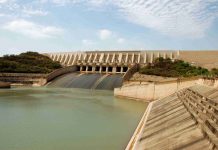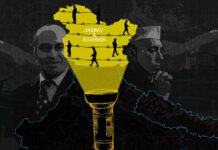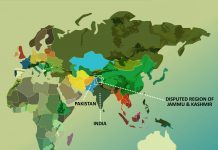I’ve included the following account to give an idea of how skewed international representations of the Princely State of Jammu & Kashmir’s are, not least because they almost all entirely rely on a small pool of ‘native’ actors committed to extolling the history and political priorities – as they imagine them – of a small area in the Princely State of Jammu & Kashmir. From these accounts, we learn nothing about the contemporary and historical peoples subsumed within the colonial borders of the erstwhile State.
The red flag between the two flags of India and Pakistan was the original flag of the ‘Dogra’ rulers of the Princely State of “Kashmir”. The Dogra rulers came from Jammu which was the winter capital of the State. Srinagar was the summer capital and entire communities would move between the two capitals during the winter and summer months.
Kashmir
“Kashmir”, region of the northwestern Indian subcontinent. It is bounded by the Uygur Autonomous Region of Xinjiang to the northeast and the Tibet Autonomous Region to the east (both parts of China), by the Indian states of Himachal Pradesh and Punjab to the south, by Pakistan to the west, and by Afghanistan to the northwest. The region, with a total area of some 85,800 square miles (222,200 square km), has been the subject of dispute between India and Pakistan since the partition of the Indian subcontinent in 1947. The northern and western portions are administered by Pakistan and comprise three areas: Azad Kashmir, Gilgit, and Baltistan, the last two being part of a territory called the Northern Areas. The southern and southeastern portions constitute the Indian state of Jammu and Kashmir. The Indian- and Pakistani-administered portions are divided by a “line of control” agreed to in 1972, although neither country recognizes it as an international boundary. In addition, China became active in the eastern area of Kashmir in the 1950s and since 1962 has controlled the northeastern part of Ladakh (the easternmost portion of the region).
Land and people
The Kashmir region is predominantly mountainous, with deep, narrow valleys and high, barren plateaus. The relatively low-lying Jammu and Punch (Poonch) plains in the southwest are separated by the thickly forested Himalayan foothills and the Pir Panjal Range of the Lesser Himalayas from the larger, more fertile, and more heavily populated Vale of Kashmir to the north. The vale, situated at an elevation of about 5,300 feet (1,600 metres), constitutes the basin of the upper Jhelum River and contains the city of Srinagar. Jammu and the vale lie in the Indian state of Jammu and Kashmir, while the Punch lowlands are largely in Azad Kashmir.
Rising northeast of the vale is the western part of the Great Himalayas, the peaks of which reach elevations of 20,000 feet (6,100 metres) or higher. Farther to the northeast is the high, mountainous plateau region of Ladakh, which is cut by the rugged valley of the northwestward-flowing Indus River. Extending roughly northwestward from the Himalayas are the lofty peaks of the Karakoram Range, including K2 (Mount Godwin Austen), which at 28,251 feet (8,611 metres) is the second highest peak in the world, after Mount Everest.
The region is located along the northernmost extremity of the Indian-Australian tectonic plate. The subduction of that plate beneath the Eurasian Plate—the process that for roughly 50 million years has been creating the Himalayas—has produced heavy seismic activity in Kashmir. One especially powerful earthquake in 2005 devastated Muzaffarabad, which is the administrative centre of Azad Kashmir, and adjacent areas including parts of India’sJammu and Kashmir state and Pakistan’s North-West Frontier Province.
The climate of the region ranges from subtropical in the southwestern lowlands to alpine throughout the high mountain areas. Precipitation is variable; it is heavier in areas that can be reached by the monsoonal winds west and south of the great ranges and sparse to the north and east where continental conditions prevail.
The people in the Jammu area are Muslim in the west and Hindu in the east and speak Hindi, Punjabi, and Dogri. The inhabitants of the Vale of Kashmir and the Pakistani areas are mostly Muslim and speak Urdu and Kashmiri. The sparsely inhabited Ladakh region and beyond is home to Tibetan peoples who practice Buddhism and speak Balti and Ladakhi.
History
Thus, the Kashmir region in its contemporary form dates from 1846, when, by the treaties of Lahore and Amritsar at the conclusion of the First Sikh War, Raja Gulab Singh, the Dogra ruler of Jammu, was created maharaja (ruling prince) of an extensive but somewhat ill-defined Himalayan kingdom “to the eastward of the River Indus and westward of the River Ravi.” The creation of this princely state helped the British safeguard their northern flank in their advance to the Indus and beyond during the latter part of the 19th century. The state thus formed part of a complex political buffer zone interposed by the British between their Indian empire and the empires of Russia and China to the north. For Gulab Singh, confirmation of title to these mountain territories marked the culmination of almost a quarter century of campaigning and diplomatic negotiation among the petty hill kingdoms along the northern borderlands of the Sikh empire of the Punjab.
Some attempts were made in the 19th century to define the boundaries of the territory, but precise definition was in many cases defeated by the nature of the country and by the existence of huge tracts lacking permanent human settlement. In the far north, for example, the maharaja’s authority certainly extended to the Karakoram Range, but beyond that lay a debatable zone on the borders of the Turkistan and Xinjiang regions of Central Asia, and the boundary was never demarcated. There were similar doubts about the alignment of the frontier where this northern zone skirted the region known as Aksai Chin, to the east, and joined the better-known and more precisely delineated boundary with Tibet, which had served for centuries as the eastern border of the Ladakh region. The pattern of boundaries in the northwest became clearer in the last decade of the 19th century, when Britain, in negotiations with Afghanistan and Russia, delimited boundaries in the Pamirs region. At that time Gilgit, always understood to be part of Kashmir, was for strategic reasons constituted as a special agency in 1889 under a British agent.
The Kashmir problem
As long as the territory’s existence was guaranteed by the United Kingdom, the weaknesses in its structure and along its peripheries were not of great consequence, but they became apparent after the British withdrawal from South Asia in 1947. By the terms agreed to by India and Pakistan for the partition of the Indian subcontinent, the rulers of princely states were given the right to opt for either Pakistan or India or—with certain reservations—to remain independent. Hari Singh, the maharaja of Kashmir, initially believed that by delaying his decision he could maintain the independence of Kashmir, but, caught up in a train of events that included a revolution among his Muslim subjects along the western borders of the state and the intervention of Pashtun tribesmen, he signed an Instrument of Accession to the Indian union in October 1947. This was the signal for intervention both by Pakistan, which considered the state to be a natural extension of Pakistan, and by India, which intended to confirm the act of accession. Localized warfare continued during 1948 and ended, through the intercession of the United Nations, in a cease-fire that took effect in January 1949. In July of that year, India and Pakistan defined a cease-fire line—the line of control—that divided the administration of the territory. Regarded at the time as a temporary expedient, the partition along that line still exists.
Although there was a clear Muslim majority in Kashmir before the 1947 partition, and its economic, cultural, and geographic contiguity with the Muslim-majority area of the Punjab could be convincingly demonstrated, the political developments during and after the partition resulted in a division of the region. Pakistan was left with territory that, although basically Muslim in character, was thinly populated, relatively inaccessible, and economically underdeveloped. The largest Muslim group, situated in the Vale of Kashmir and estimated to number more than half the population of the entire region, lay in Indian-administered territory, with its former outlets via the Jhelum valley route blocked.
Chinese interests
China had never accepted the British-negotiated boundary agreements in northeastern Kashmir. This remained the case following the communist takeover in China in 1949, although the new government did ask India—without success—to open negotiations regarding the border. After Chinese authority was established in Tibet and reasserted in Xinjiang, Chinese forces penetrated into the northeastern parts of Ladakh. This was done mainly because it allowed them to build a military road through the Aksai Chin plateau area (completed in 1956–57) to provide better communication between Xinjiang and western Tibet; it also gave the Chinese control of passes in the region between India and Tibet. India’s belated discovery of this road led to border clashes between the two countries that culminated in the Sino-Indian war of October 1962. China has occupied the northeastern part of Ladakh since the conflict. India refused to negotiate with China on the alignment of the Ladakhi boundary in this area, and the incident contributed significantly to a diplomatic rift between the two countries that began to heal only in the late 1980s. In the following decades, China worked to improve its relations with India, but there has been no resolution to the disputed Ladakh frontier.”
Excerpt from Encyclopaedia Britannica.
















